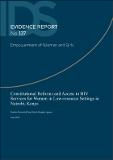| dc.contributor.author | Oosterhoff, P | |
| dc.contributor.author | Kageha Igonya, E | |
| dc.coverage.spatial | Kenya | en |
| dc.date.accessioned | 2015-06-11T09:58:03Z | |
| dc.date.available | 2015-06-11T09:58:03Z | |
| dc.date.issued | 2015-06 | |
| dc.identifier.citation | Oosterhoff, P. and Kageha Igonya, E. (2015) Constitutional Reforms and Access to HIV Services for Women in Low-resource Settings in Nairobi, Kenya, IDS Evidence Report 137, Brighton: IDS | en |
| dc.identifier.uri | https://opendocs.ids.ac.uk/opendocs/handle/20.500.12413/6316 | |
| dc.description.abstract | After more than two decades of agitation for a new constitution, the violence that followed
Kenya’s 2007 presidential elections finally led to a reform movement to overhaul the way the country was governed. On 4 August 2010, voters approved a new Constitution by a clear majority, reflecting a widespread desire for change. The aim was to improve government accountability and democracy by reorganising the government. There are now more checks and balances, parliamentary oversight of the executive is stronger, and the Bill of Rights provides greater protection for citizens, including women and minorities.
Perhaps the most profound change is devolution: the transfer of power from the centre to
regional authorities. In the case of Kenya, devolution has meant granting statutory powers to the counties. The devolution of health services began in 2013 with the election of governors and county principals. Devolution potentially has wide-ranging implications for Kenya’s health sector, which is already failing on several levels. In Kenya, the prevalence of the human immunodeficiency virus (HIV) slowed from between 13 per cent and 15 per cent of the general population in 1999 to 5.6 per cent in 2012. Nevertheless, this is still one of the highest rates of HIV infection in the world. Women in Kenya have been disproportionately affected by HIV. Four years after the approval of the new Constitution, this case study examines: the difficulties that poor women and girls living in slum areas face in getting access to HIV services, including anti-retroviral treatment (ART); their perception of how devolution has affected HIV and other health-related services; and their ability to participate in political decision-making and to bring about change at the local level. Are HIV-positive women and girls in slums able to get the attention of policymakers at the county level in order to get the services they need? | en |
| dc.description.sponsorship | UK Department for International Development | en |
| dc.language.iso | en | en |
| dc.publisher | IDS | en |
| dc.relation.ispartofseries | IDS Evidence Report;137 | |
| dc.relation.ispartofseries | IDS Evidence Report Brief;137 | |
| dc.rights.uri | http://creativecommons.org/licenses/by/3.0/ | en |
| dc.subject | Gender | en |
| dc.subject | Governance | en |
| dc.subject | Health | en |
| dc.subject | HIV/AIDS | en |
| dc.subject | Politics and Power | en |
| dc.title | Constitutional Reforms and Access to HIV Services for Women in Low-resource Settings in Nairobi, Kenya | en |
| dc.type | IDS Evidence Report | en |
| dc.rights.holder | IDS | en |
| dc.identifier.ag | OT/11009/3/2/2/90 | |
| dc.identifier.ag | OT/11009/3/2/2/91 | |



